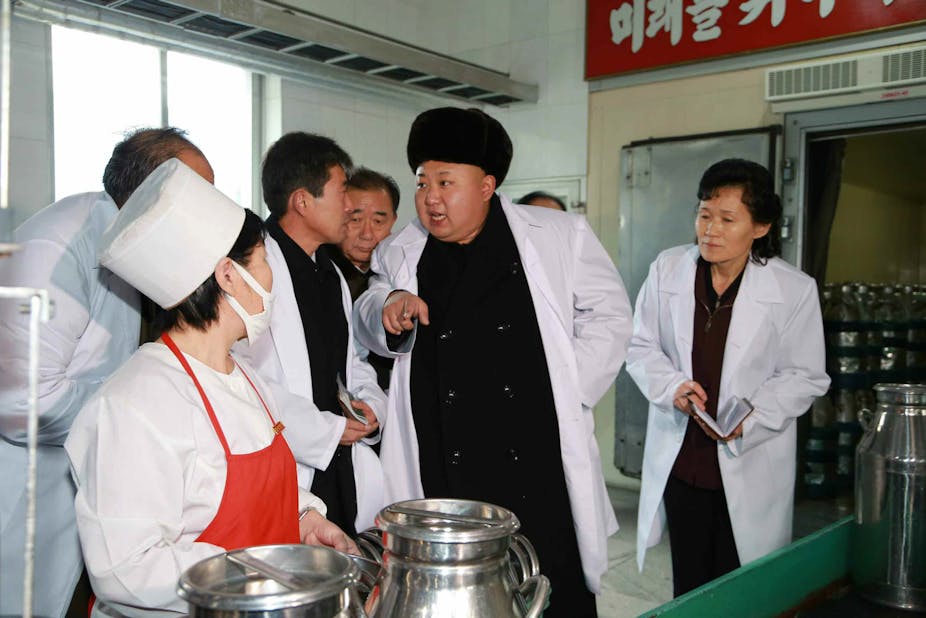If North Korea prides itself on the West never quite knowing what it will do next, there is a fantastic new example worth savouring. Plans are reportedly afoot to open a North Korean restaurant in Scotland – the first in the UK and second in Europe after Amsterdam. They are both part of the same chain, which is otherwise concentrated in Asia and owned by the North Korean government as a means of raising extra funds.
The Kim Jong-un regime would certainly be capitalising on the growing popularity of Korean food. It may still be considered more exotic than Chinese and Japanese fare, but this is changing fast. In the US, the average price of a meal in a Korean restaurant has been constantly rising for the past two decades, in what is a sign of growing prestige. It continued to climb even after 2010, when the prices of Japanese restaurants began to drop.
Changing US restaurant prices

This may be partly a result of the Korean Cuisine (Hansik) Promotion Campaign, which was initiated by the South Korean government in 2009 with the goal of turning Korean food into one of the five most popular ethnic cuisines in the world by 2017. The plan is currently being rethought after receiving much criticism in the media, but there are nonetheless plenty of signs that the country’s cuisine is on the rise.
Seoul nights
London has more than its fair share of Korean restaurants. The Camden area has so many that it is sometimes informally known as Little Seoul. But until a few years ago, these restaurants were primarily patronised by Korean and Japanese businessmen. One of the key drivers for this changing was the arrival of Bibigo in 2012 – not in Camden but in Soho, in the middle of town.
Camden’s Korean preponderance

Bibigo clearly caters to a local clientele hungry for an exotic experience. It was the first European outlet of the South Korean restaurant chain, managed by C J CheilJedang, Korea’s number-one food and bio business, and was followed by a second London opening in the Angel area last week.

The business launched in 2010 as one of the strategies of the government’s promotion campaign and has since also expanded to Beijing, Jakarta, Los Angeles, Singapore and Tokyo. What has worked for the South Korean government, clearly their northern neighbours think can work for them too.
North Korean restaurants are a relatively new addition to the global gastronomic scene. They began to emerge in north China during the 1990s and a decade later began to spring up in Jakarta, Hanoi, Kuala Lumpur and other cities across Asia. The Amsterdam restaurant opened in 2012, before closing and reopening in a different location in 2013.
Southern rice and northern noodles
Culinary culture in the Korean peninsula developed locally for centuries, leading to noticeable differences in ingredients and flavours. The food of the northern provinces tended to be less spicy due to the colder climate, for example.

The consumption of noodles is more widespread, since rice agriculture flourished primarily in the south. The most celebrated North Korean dish today is raengmyeon (“cold noodles”), a vinegary dish that comes in various varieties with chewy noodles made from either buckwheat or sweet potato. It only began to be consumed in the south after it was popularised by the North Korean refugees who flocked there after the Korean war (1950-1953).
But what will really distinguish a North Korean restaurant from one dishing up southern fare is the ambience and the song-and-dance routines, which are a unique mix of folklore and Stalinism, with added karakoe. The actual menus will not be much different, on the other hand. For example, the one in Amsterdam offers the Korean classics, such as pulgogi (thin slices of marinated beef grilled at the table), kimchi (pickled vegetables), and pibimpap (rice mixed with vegetables) – as well as sushi and sashimi, which are Japanese but are often served in Korean restaurants in the US to capitalise on the popularity of that cuisine.
North Korea’s marketing advantage
Just because the menus might be similar, this by no means implies that there are parallels in the contemporary culinary culture of North and South Korea. Affluence, the food processing industry and foreign culinary trends have transformed dietary life of South Korea since the 1980s, which has widened the breach with its North Korean neighbour at the same time.
Ironically the image of North Korea as the “nostalgic past”, good old Korea frozen in time, has grown into a powerful marketing tool for North Korean products on sale in South Korea.
With both Korean governments now pushing their countries’ cuisines, it raises questions about who owns the property rights to Korean food. Where lies the legitimate source of the authentic Korean culinary tradition? This means that dining at a North Korean restaurant, whether in Amsterdam, Beijing, Hanoi or Scotland is much more than a culinary delight and exotic experience. It is a lesson in history and global politics as well.

